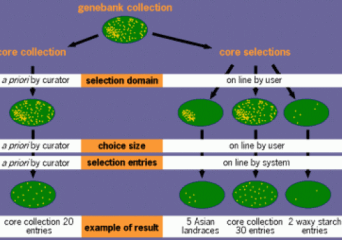
Core collections
Due to the size of, and lack of proper information about many germplasm collections, choosing material is not always easy. Core collections aim at presenting the user with a subset of material that contains as much diversity as possible, given the requirements for this set.
A germplasm collection is usually the result of historical events and arbitrary decisions; collecting missions and specific research programs often result in over representation of certain material whereas other types of material can be underrepresented. Core collections try to increase the balance between the types of material in a relatively small selection of accessions.
The size of a germplasm collection can limit its accessibility, and thus hinder its utilisation and management.
Continue to:
Some of the problems caused by the large size of a germplasm collection are:
- it is difficult to get an overview of the collection and thus to decide what should be a added or could be removed,
- it is difficult to chose material since there is so much material to chose from,
- it is difficult to focus; knowing very much about a relatively few accesions can be better than knowing relatively little about very many accessions.
To improve this situation it has been proposed to select a limited set of accessions from the collection with as much genetic diversity as possible: a core collection. SIr Otto Frankel introduced this concept in 1984 and defined it as 'a limited set of accessions which represents, with a minimum of repetitiveness, the genetic diversity of a crop species and its wild relatives'.
The idea was picked up and applied by the genebank community. It evolved in a concept in which a selection of one or more germplasm collections is made to optimally represent diversity and to meet the requirements of the users. If this set is more or less fixed, and used for different purposes, the term 'core collection' is still applied, if the selection is made to answer to a specific request the term 'core selection' is more appropriate.

